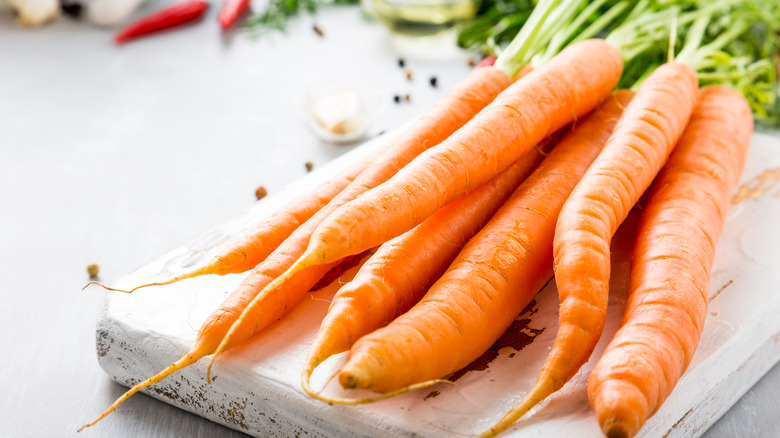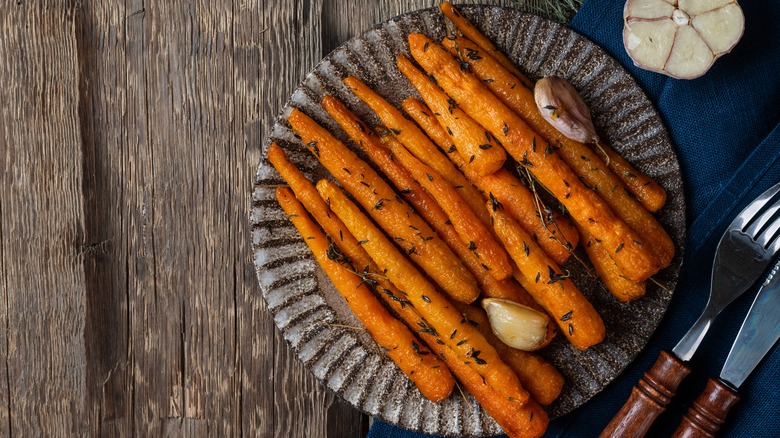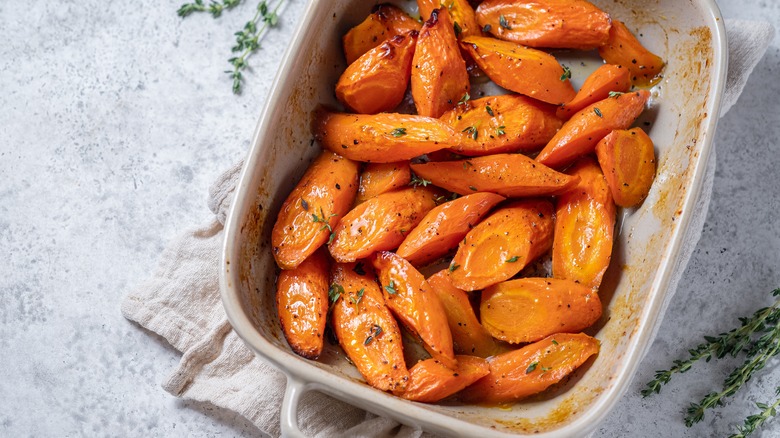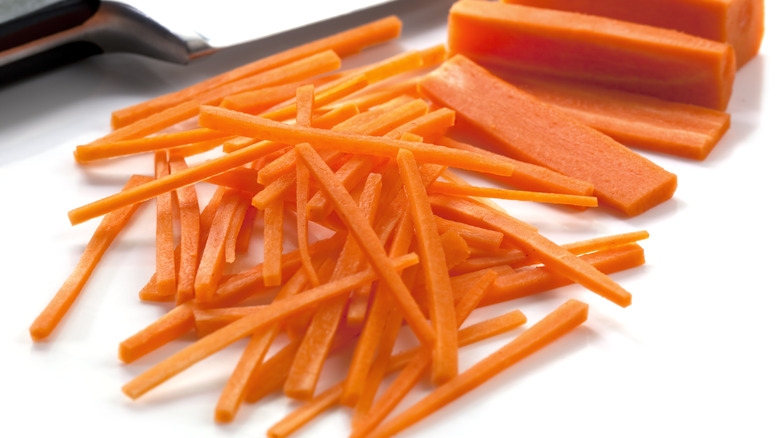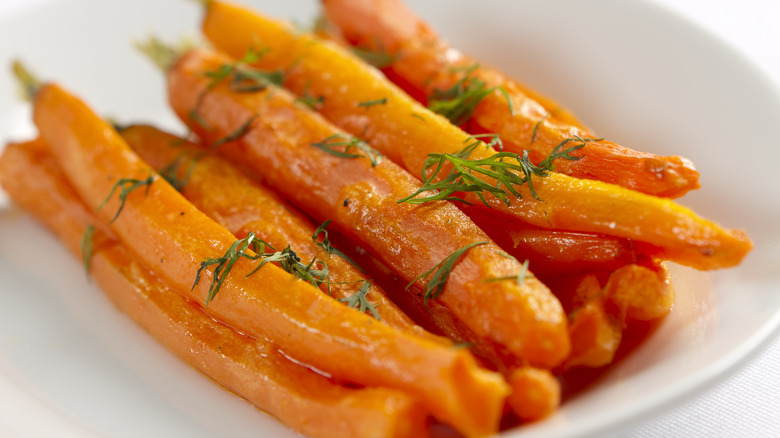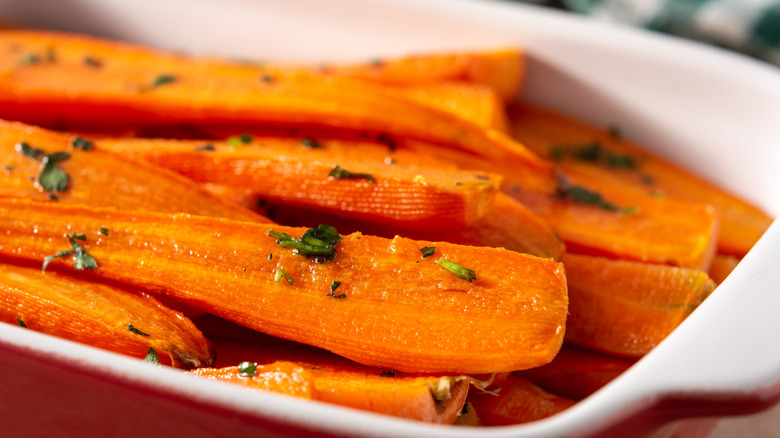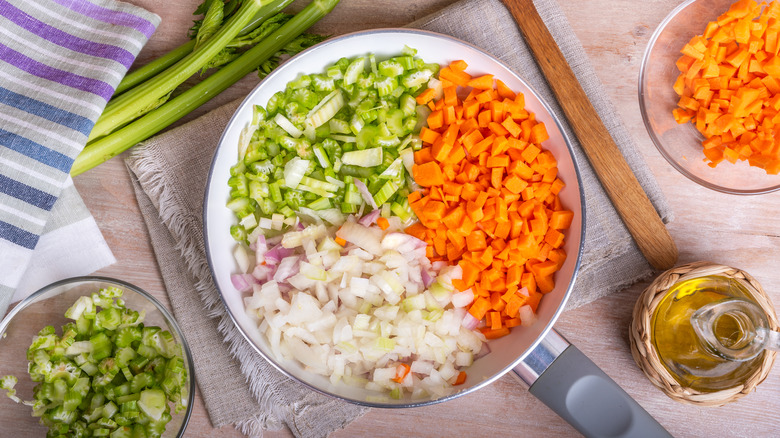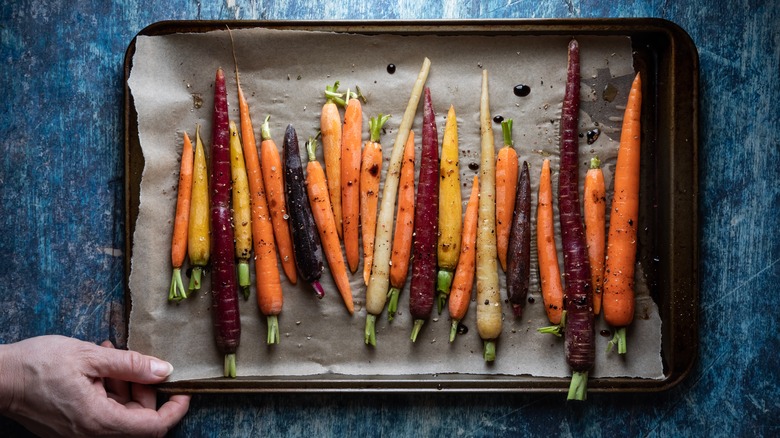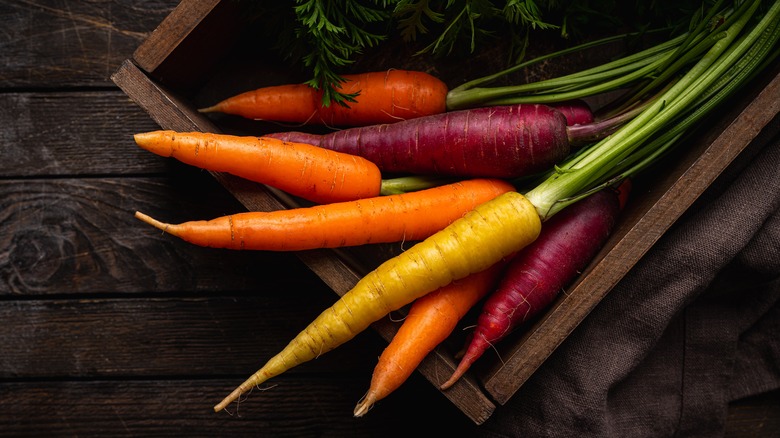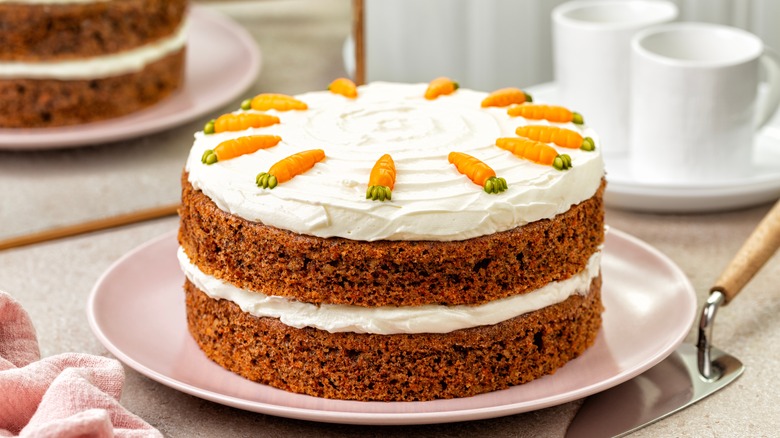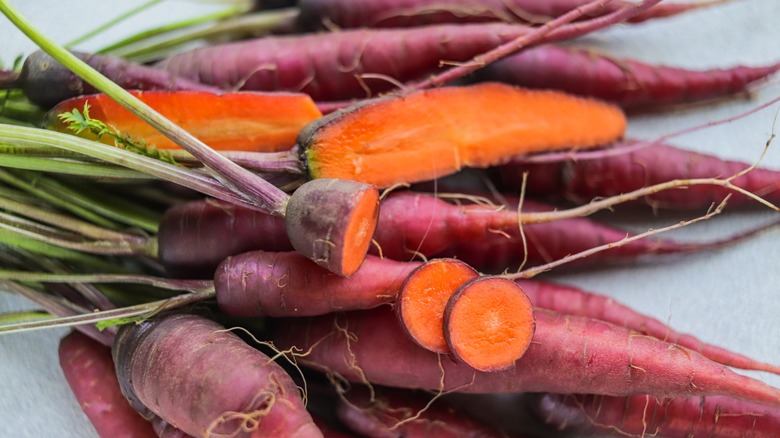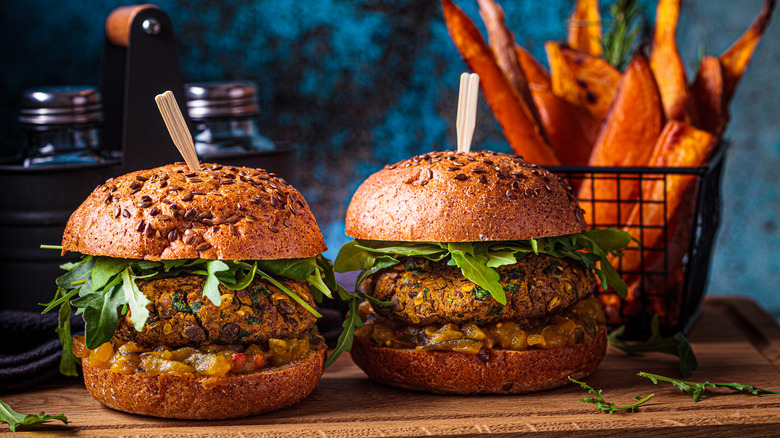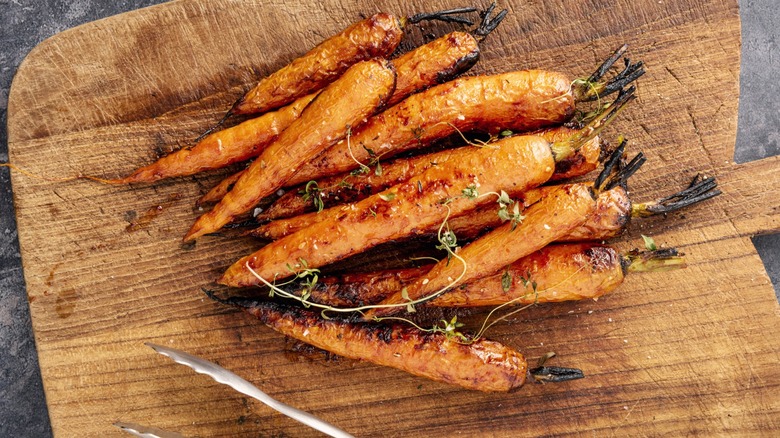Mistakes Everyone Makes When Cooking Carrots
Cooking with carrots might seem simple. They're one of the most popular vegetables around, and they are cooked in everything from cakes to stews. However, many home cooks aren't making the most of carrots. Maybe you keep cooking carrots that are watery or tasteless. Or perhaps you just feel like there are more fresh and exciting ways you could use them. There are some common mistakes that everyone makes when cooking with carrots that it pays to avoid.
For starters, so many people think that boiling carrots is the only option, when actually there are many ways to cook them — most of which give tastier results. Then, there's the issue of seasoning. More often than not, folks don't know how to branch out past salt and pepper. Yes, this is a classic pairing for a reason, but it's a shame not to experiment further. And that's just the tip of the iceberg.
It's sad how many people are eating under-seasoned, lackluster carrots when they could be enjoying them in all their sweet, complex glory. Never again should anyone be doomed to eat bland, soggy carrots. In this article, you'll learn about the mistakes everyone makes with carrots and how to resolve them.
Thinking that boiling is the only option
If boiling carrots is your go-to cooking method, you're making a mistake. Boiled carrots are a classic, simple side, but it's definitely not the most delicious way to cook them. While there are other options, roasting and sautéing carrots are two of the most flavorful options. Boiled carrots can be watery and bland while roasting and sautéing bring out the natural sweetness of carrots and intensifies their delicious flavors.
One of the best ways to roast carrots is whole. Although you can half or quarter them, especially large specimens. This is an especially good idea if your carrots are a range of thicknesses, otherwise, the thinnest carrots may burn before the thickest carrots are cooked through. Roasting time varies depending on carrot thickness and how soft you want them, but somewhere between 30 minutes to an hour is good in most cases.
Then there's the sautéing method. If you want to cook carrots this way, they're best grated, thinly sliced, or sliced into ribbons with a peeler. However, if you want to sauté thicker pieces of carrots, you can combine braising and sautéing. First, braise your carrots in a liquid of your choice, such as water or stock, for 6 to 7 minutes. Once the water has evaporated, add some oil and sauté to finish off the cooking process. Plus, you can cook them in other recipes, such as in soups and stews.
Cooking them for too long or not long enough
Have you ever ended up with carrots that were mushy and soggy? Or on the other end of the spectrum, have you bitten into a "cooked" carrot that was practically raw? If so, those carrots were either overcooked or undercooked. Both options can give you subpar carrots. While the watery, too-soft texture of overcooked carrots is unpleasant, we also don't want a raw carrot when we're expecting a cooked one.
Luckily, the solution is simple if you've been cooking your carrots for too long or not long enough: learn the proper cooking times for different methods of cooking carrots. If you're boiling carrots, quarter-inch rounds take 7 to 9 minutes, strips take 4 to 6 minutes, and baby carrots take 8 to 10 minutes. Steaming carrots takes around 8 to 10 minutes for baby carrots and quarter-inch rounds or 5 to 7 minutes for strips.
If you want to roast carrots whole, it takes about 40 to 60 minutes, depending on the diameter of the carrot. If in doubt, start checking after around 30 minutes. The beauty of roasted carrots is that it's much more difficult to overcook them. They don't get soggy when they're well-cooked and are beautifully tender. You mostly have to watch them to make sure they don't burn. You can definitely undercook them, though. Roasted carrots are quite disappointing when they're too hard.
Only slicing them into rounds
We all know that classic carrot slice: round circles across the diameter, roughly a quarter-inch thick. While there's nothing wrong with cutting your carrots this way, it's certainly not your only option. You're missing out on the chance to expand your horizons if you stick with just this one cut.
But what are the alternatives? First, let's talk about carrot batons. These are around 2 to 3 inches long and ½-inch by ½-inch thick. While this is a popular way to eat carrots raw, they're also great for glazing and for roasting when you don't have the time to roast whole carrots. Plus, there's a smaller batonnet cut that's around 2 inches long and ¼-inch by ¼-inch thick.
You can also julienne carrots into strips that are around 1 to 2 inches long and ⅛-inch by ⅛-inch thick. They're great for sautéing or tossing into stir-fries. You can also make a brunoise dice by chopping your julienned carrots into ⅛-inch cubes. These are great to use in the base of sauces where you want the carrots to basically melt away. Of course, you can also opt for larger slices, as appropriate. Then, there's the option to grate your carrots. Grated carrots add texture to recipes, such as stir-fries and salads. You can also use them in carrot cakes and other sweet bakes, but you should use the smaller holes on your box grater for those.
Not experimenting with seasonings
You might think of carrots as a fairly traditional side and therefore only season them simply with salt and pepper. This is a mistake that many home cooks make, but one that you should rectify as soon as possible if you want the best-tasting carrots. So, what are some of the best ways to season carrots? Dill is a popular choice, especially for roasted carrots, with some salt and olive oil or butter. If you're looking for another fresh herb, cilantro also goes well. It's a popular choice for soup, but you can also use it in other contexts.
The Middle Eastern spice blend za'atar is delicious with roasted or sautéed carrots. It's wonderful served with labneh or a yogurt sauce and some toasted pistachios. If you want to add a little spice, try roasting or sautéing your carrots with harissa or berbere (an Ethiopian and Eritrean spice blend).
All these options are good places to start, but you can experiment with your choice of herbs and spices. There are few that won't go with carrots, even if it's a non-traditional choice.
Using too much liquid for glazed carrots
If you've tried glazing carrots and have found them underwhelming, you might be using too much liquid. When you use an excess of liquid to make glazed carrots, it can ruin them in a range of ways. Firstly, your carrots might just end up simmering away in the liquid, with it never getting thick enough to coat them. In this case, not only will your carrots not end up glazed, but there's also a risk of overcooking the carrots. They might become mushy and lose their texture. Plus, with excess liquid, even if the glaze eventually thickens, it will take longer for the liquid to reduce and the thickening to occur. The longer cooking time will potentially result in overcooked or soggy carrots.
Then, there's the issue of flavor dilution. Too much liquid can dilute the flavor of the glaze, making the carrots less flavorful. The balance between sweetness, acidity, and other seasonings may be compromised. To avoid these issues, it's important to follow the recipe instructions carefully and adjust the liquid components accordingly. If you find that there's too much liquid during the cooking process, you can try draining some of it or allowing it to evaporate by increasing the heat. Adding more sugar or other thickening agents can help in adjusting the consistency of the glaze.
Not using them in a mirepoix or soffritto
Yes, you can absolutely eat carrots on their own as a side dish, but there are more ways of incorporating them into recipes. Not only do these give you an extra nutritional boost, but it also boosts flavor. So, if you're not using them in a mirepoix or a soffritto, you're missing out — but what are you missing out on, exactly?
A mirepoix is a mixture of diced vegetables used as a flavor base in many dishes, particularly in French cuisine. It consists of three main ingredients: onions, carrots, and celery. The classic ratio for a mirepoix is 2 parts onions to 1 part each of carrots and celery. The mirepoix serves as the foundation for a wide variety of soups, stews, sauces, and braises. When cooked together, these aromatic vegetables release their flavors and aromas, enhancing the overall taste of the dish.
A soffritto is an Italian flavor base made by sautéing a mixture of finely chopped aromatic ingredients. Similar to the French mirepoix, the soffritto serves as a foundational element in many Italian dishes, providing depth and complexity to the flavor profile. Like a mirepoix, there's a ratio of 2 parts onion to 1 part carrot and 1 part celery. However, there's more regional variation when it comes to soffrittos. They can also contain herbs and additional aromatics, such as garlic.
Crowding the pan when roasting them
Are you sick of roasted carrots coming out soggy and wondering where you're going wrong? The answer might be that you're crowding your pan. Crowding the pan when roasting carrots can cause a range of issues. But don't worry, it's a totally common mistake that many people make — and it's super simple to solve.
What happens when carrots are crowded? Firstly, proper roasting requires hot air to circulate around the vegetables. Crowding the pan impedes air circulation, and the trapped steam can make the carrots soggy instead of achieving the desired roasted texture. But roasting isn't just about cooking the vegetables; it's also about achieving caramelization on the surface for enhanced flavor. Crowding the pan can prevent proper caramelization due to the moisture released by the vegetables.
What's more, when carrots are too crowded, they may not cook evenly. The vegetables in the center of the crowded pan might steam rather than roast, resulting in uneven texture and doneness. They can also take longer to cook because the oven heat has to work through the mass of vegetables. Luckily, it's easy to avoid these issues. All you need to do is arrange the carrots in a single layer with some space between them on the roasting pan. This allows for even cooking, proper caramelization, and the perfect texture.
Only using orange carrots
Most people are used to carrots being orange, which is indeed their most common color. However, it's fascinating to note that carrots come in a variety of colors. Their hues can range from red and yellow to purple and white. The different colors in carrots are due to the presence of various pigments, such as beta-carotene (which gives the orange color), anthocyanins (responsible for red and purple hues), and xanthophylls (resulting in yellow and white colors).
Carrot color variations aren't just a result of modern cultivation; they have a rich history. Originally, carrots were purple or white. Legend has it that the orange variety emerged later through selective breeding in the Netherlands to honor the Dutch royal family, the House of Orange. However, this is likely a fabrication. Orange carrots started showing up in Italian and Spanish artwork in the 1500s and are likely a natural occurrence.
While orange carrots are the norm today, experimenting with rainbow-colored carrots is still fun. It's interesting to note that despite their diverse colors, rainbow carrots share a similar taste profile. They all have that familiar sweet and earthy flavor, making them interchangeable in various recipes. So, don't hesitate to explore the world of rainbow-colored carrots in your cooking, even if it's just to impress your guests or family members with their fun hues.
Ignoring sweet recipes
Don't limit yourself to savory carrot recipes — there are so many sweet recipes you can try, too. Of course, we all know about carrot cake. This popular bake includes grated carrots, nuts, and spices like cinnamon and nutmeg. People commonly top it and fill it with cream cheese frosting. Then, there are variations on classic carrot cake, such as carrot cupcakes and carrot muffins.
But it certainly doesn't stop there. Carrot cookies are another great option. Incorporate grated carrots into cookie dough for a unique twist. Consider adding oats, raisins, or nuts for additional flavor and texture. There's also carrot halwa, which is a traditional Indian dessert made by cooking grated carrots with ghee, milk, sugar, and nuts until it reaches a rich and creamy consistency.
Looking for something summery? Combine puréed carrots with sugar and citrus juice to create a refreshing carrot sorbet. Or you could experiment with adding shredded carrots to brownies to bring some sweet, earthy notes. There are so many sweet recipes that use carrots that you've got plenty to work with.
Not removing the core from large carrots
As carrots age or grow larger, the central core can sometimes become woody, fibrous, and less palatable. This woody core is characterized by a tougher texture and can be less enjoyable to eat compared to the tender outer parts of the carrot. So, if you aren't removing it when necessary, you're making a mistake.
Here's the good news: removing the core from a carrot is a simple process. Begin by cutting off both ends of the carrot using a sharp knife. This provides a stable base for further cutting. Cut the carrot in quarters lengthwise to expose the inner core. Examine the cut quarters to identify the woody core. It typically appears as a distinct, lighter-colored section in the center. Finally, use your knife to carefully make cuts on either side of the core, down the length of the carrot, before snapping it out. Now, you've got rid of that woody center and it won't ruin the texture of your cooked carrots. Depending on your recipe, you can proceed to chop, slice, or grate the carrot as needed for your dish.
Always relegating them to a side dish
Carrots are a hugely popular side dish. But are you only ever eating them as a side? If so, it's time to expand your horizons and turn carrots into the star of the show occasionally. It's a good chance to try some recipes that might otherwise have passed you by. What's more, carrots are one of the cheapest veggies out there, so using them as a major component in a dish is a great way to cut your grocery bills.
Still, you might be wondering what kinds of main dishes you can make with carrots. You have plenty of options — a quick Google search will help you out here — but we'll go into detail about a handful of potential recipes to get you started. One option is to make carrot cakes or carrot fritters. These may use flour to bind pieces of carrot together before frying or include extra hearty ingredients, such as beans or lentils. A similar option is to form carrots into patties with beans, rice, and other fillers, eating them as veggie burgers with all the trimmings. Carrot makes a good main ingredient in recipes like pasta, couscous, or noodles. For instance, if making a fried noodle dish, you can make carrot ribbons and stir-fry them with your noodles. Carrot gnocchi is another great choice, with carrots taking the place of potatoes in the gnocchi dough.
Not browning them
Do you avoid browning your carrots for fear of them being overcooked? Well, this is something you need to stop, because browning them is the ticket to even more delicious flavor. Browning carrots, or any vegetables, enhance their flavor through caramelization and a process called the Maillard reaction. But how does this lead to better flavors?
Browning occurs when the natural sugars in the carrots are exposed to heat, causing them to caramelize. This process involves the breakdown of sugars into new compounds, creating a sweet and rich flavor. The browning intensifies the sweetness of the carrots, providing a more nuanced and complex taste.
The Maillard reaction takes place between amino acids and reducing sugars when exposed to high temperatures. It results in the formation of a wide range of flavorful compounds, contributing to the characteristic taste of browned or roasted foods. In the case of carrots, the Maillard reaction can generate nutty, toasty, and savory notes, enhancing the overall flavor profile.
Browning also leads to the development of aromatic compounds, creating a more fragrant and appetizing scent. The aroma plays a crucial role in the perception of flavor, making the dish more enticing and enjoyable. Plus, the browning process can impact the texture of the carrots, giving them a slightly crispy exterior while maintaining a tender interior. This contrast in texture adds depth to the overall eating experience.
